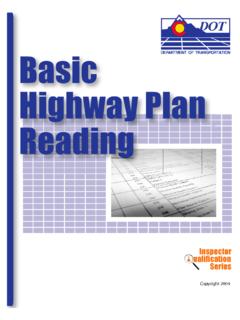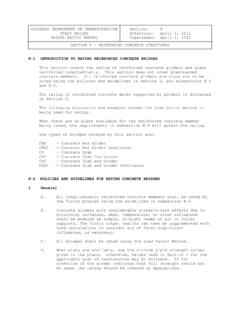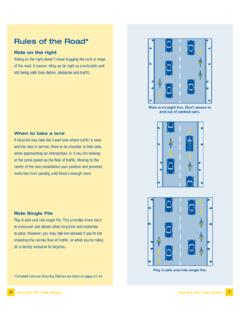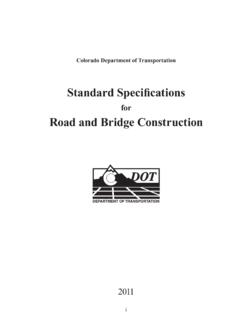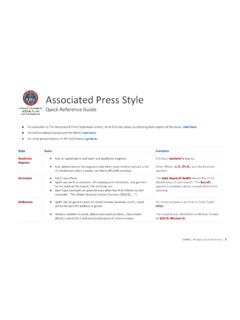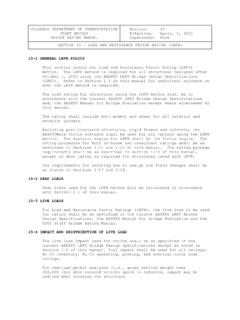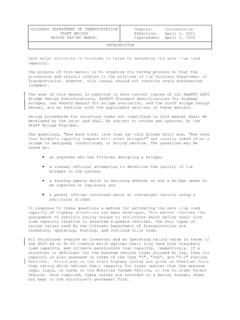Transcription of SECTION 31: PEDESTRIAN STRUCTURES 31-1
1 SECTION 31: PEDESTRIAN STRUCTURES 31-0 CDOT Bridge Design Manual February 2023 SECTION 31 PEDESTRIAN STRUCTURES GENERAL REQUIREMENTS This SECTION addresses design and performance requirements for typical PEDESTRIAN bridges intended to carry pedestrians, bicyclists, equestrian riders, and light maintenance vehicles. CODE REQUIREMENTS Design shall be in accordance with the AASHTO Standard Specifications for Highway Bridges, except as modified by the AASHTO LRFD Guide Specifications for the Design of PEDESTRIAN Bridges and this BDM.
2 PERFORMANCE REQUIREMENTS Service Life PEDESTRIAN bridges must be designed to achieve a minimum service life of 75 years. Maintenance Requirements PEDESTRIAN bridges should be designed to allow ease of inspection and maintenance. Periodic preventive maintenance and inspections will be performed on all PEDESTRIAN bridges to extend the service life of the structure . Preventive maintenance may include cleaning, removing debris, painting, sealing deck joints, etc. Aesthetic Goals Refer to SECTION of this BDM for information about aesthetic requirements.
3 GEOMETRY AND CLEARANCES Geometry Width Bridge deck width should be based on the type of anticipated local usage and corresponding current ADA Standards for Accessible Design guidelines. Clear width should be measured from face to face of rail. Wider bridges are preferred for two-directional PEDESTRIAN traffic rather than narrow decks with passing spaces due to the difficulty in design and constructability of the landings. However, when passing spaces are used, they should conform to ADA requirements and be located at reasonable intervals, not to exceed 200 ft.
4 Coordinate with the local agency to determine the final SECTION on a PEDESTRIAN or bicycle bridge. Refer to Chapter 14 of CDOT Roadway Design Guide for additional PEDESTRIAN facilities geometry requirements. SECTION 31: PEDESTRIAN STRUCTURES 31-1 CDOT Bridge Design Manual February 2023 Profile and Grade Refer to current ADA Standards for Accessible Design for maximum grade allowed on PEDESTRIAN bridges. PEDESTRIAN bridges over waterways shall satisfy all requirements set for vehicle bridges for freeboard, scour, and overtopping.
5 Ramps PEDESTRIAN overpass STRUCTURES , if practical, may be provided with both ramps and stairways, but under no condition should a structure be built with stairs only. Maximum grades on approach ramps shall conform to ADA requirements. Whenever existing STRUCTURES or other local constraints prevent design of the structure that satisfies maximum grade requirement, landings shall be provided to accommodate a maximum rise of ft. Landings shall be level, the full width of the bridge, and a minimum of 5 ft.
6 In length. Landings shall also be provided whenever the direction of the ramp changes. However, straight grades or vertical curves are preferred instead of landings whenever possible. The deck and ramps shall have a non-skid surface, such as a transverse fiber broom finish for concrete. Concrete bridge decks must have transverse joints to minimize map cracking. The Designer shall specify the spacing of the joints. Physical Requirements The structure Selection Report should evaluate all feasible structure types.
7 The deck of the bridge should maintain the cross-slope of the approach trail. Cover plates should be provided at all expansion joints to minimize tripping hazards. Approach slabs are not required on PEDESTRIAN bridges unless requested by the Owner. SECTION of this BDM outlines the requirements for the PEDESTRIAN and bicycle railing. Vertical Clearances The minimum vertical clearance from an under-passing roadway surface to a PEDESTRIAN bridge shall be ft. as outlined in SECTION of this BDM.
8 The minimum vertical clearance from a PEDESTRIAN or bicycle path to an overhead obstruction shall be 8 in., or 10 ft. for an equestrian path, measured at 1 ft. from the face of curb , parapet, or rail. Horizontal Clearances Horizontal clearances shall conform to AASHTO. AASHTO SECTION 31: PEDESTRIAN STRUCTURES 31-2 CDOT Bridge Design Manual February 2023 LOADS AND DEFLECTIONS Live Loads Pedestrians Refer to the current edition of AASHTO LRFD Guide Specifications for the Design of PEDESTRIAN Bridges for the design value of the PEDESTRIAN live load.
9 Maintenance Vehicles Whenever vehicle access is not prevented by permanent physical methods, PEDESTRIAN /bicycle bridges shall be designed for vehicle live load. In most cases, maintenance vehicle H5 or H10 will be used (refer to AASHTO LRFD Guide Specifications for the Design of PEDESTRIAN Bridges for maintenance vehicle configurations). However, in some locations PEDESTRIAN bridges are expected to carry emergency vehicles and construction live loads, such as firetrucks in rural areas where no other route is available.
10 In such instances, PEDESTRIAN STRUCTURES must be designed to carry CDOT Legal Load Type 3 (shown on Figure 31-1). The Designer must coordinate with Staff Bridge and the local authority to determine the type of live load required on each PEDESTRIAN bridge. The structure Selection Report and bridge project special specification must discuss live load selection. No vehicle live load is required for bridges with clear widths equal to or less than 7 ft. All PEDESTRIAN bridges designed to carry vehicle load must be rated, with the rating factor specified on the plans or shop drawings.
